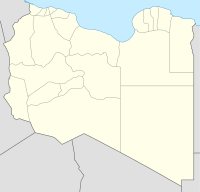| Bir Hakeim rescue | |||||||
|---|---|---|---|---|---|---|---|
| Part of the Senussi campaign | |||||||
 Bir Hakeim (red) and Sollum (blue) on a 1916 British map | |||||||
| |||||||
| Belligerents | |||||||
|
|
| ||||||
| Commanders and leaders | |||||||
|
| |||||||
| Strength | |||||||
| 45 vehicles | Senussi guards | ||||||
| Casualties and losses | |||||||
| None | |||||||
Bir Hakeim, the site of an Ottoman fort built around a Roman well | |||||||
The Bir Hakeim rescue (Arabic: بئر حكيم, romanized: biʾr ḥakīm, lit. 'Wise Well' pronounced [biʔr ħaˈkiːm] ) was a British raid in Italian Cyrenaica (modern Libya) on 17 March 1916 to recover prisoners of war held by the Senussi. Following the capture of Sollum on 14 March the British discovered evidence that the prisoners, survivors from two ships sunk by a German U-boat, were being held at the Bir Hakeim oasis, about 99 mi (160 km) to the west.
A rescue force of armoured cars and ambulances was assembled by Major Hugh Grosvenor, 2nd Duke of Westminster. The force, starting before dawn, drove across the desert and surprised the Senussi guards. On finding the prisoners had been half-starved during their 135 days' captivity the British pursued the fleeing Senussi and massacred most of them, including women and children. The party then returned to Sollum.
